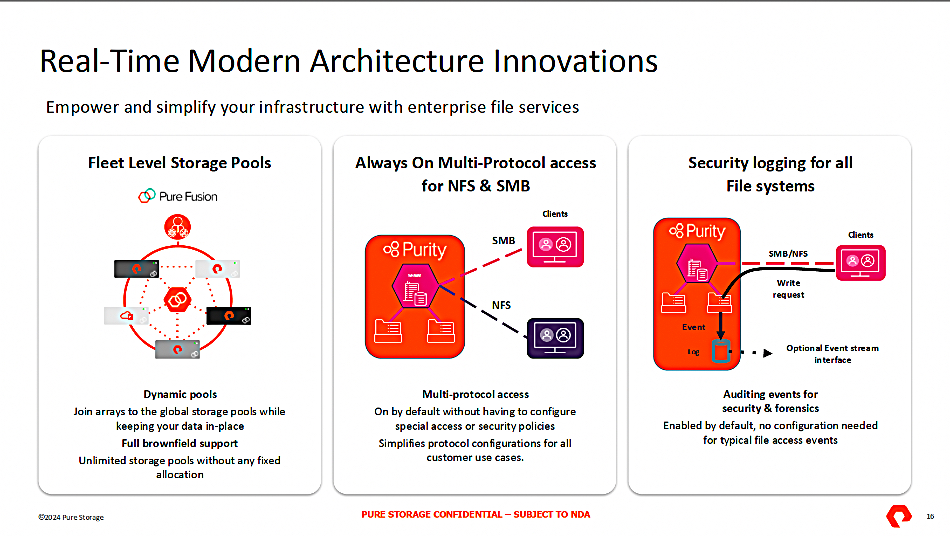Pure Storage is providing a set of fleet and cluster level FlashBlade file services that make it easier to operate and manage large-scale file environments in a cloud-like way, plus an entry-level FlashBlade//S100 system, and doubled Direct Flash Module (DFM) maximum capacity to 150 TB.
FlashBlade is Pure’s all-flash, unified file and object storage system, operated by the Purity OS. Pure is adding two software capabilities for multiple storage classes – Fusion for Files and Zero Move Tiering – plus Real Time Enterprise File services with always-on multiple protocol, auditing, QoS, SMT for file and the AI Copilot. The company is also adding universal (cross-product) licensing credits and a VM Assessment service to help optimize Pure customers’ on-prem and public cloud storage for virtual machine (VM) workloads in light of Broadcom changes to VMware licensing conditions and costs. Overall it claims that legacy file storage is restricting customers’ ability to meet modern file workload requirements.
Chief product officer Ajay Singh said in a statement: ”For years, outdated and rigid legacy file storage has done customers a huge disservice by holding them back and forcing them towards frequent technology refresh cycles. Through the Pure Storage platform, Real-time Enterprise File along with the new VM assessment and Universal Credits empowers our customers to navigate today’s fast-moving, complex business environment with confidence.”

Pure says its Real-time Enterprise File offering enables file services to dynamically change, adapt, and reconfigure in real time. With Fusion, there are now fleet-level global storage pools – unlimited storage pools without any fixed allocation. Pure arrays can join a global storage pool while keeping data in place.
The Purity OS supports both SMB and NFS file access protocols by default and also logs write requests by default for subsequent auditing with log configuration required. It solves noisy workload neighbor problems by having always-on quality of service to prevent any one workload using excessive resources and bottlenecking performance.
Purity can now virtualize a FlashBlade system into so-called servers. These, Pure claims, “provide data access isolation for file workloads enabling customers to service multiple untrusted domains, present multiple share or export namespaces, or share data between different untrusted domains.”
The Zero Move Tiering idea enables different storage performance classes by having a single QLC DFM storage base and applying faster or slower compute and network resources to data accesses for hot or cold data respectively. It’s quasi-storage tiering in that data does not move between storage tiers, as is usually the case, to save costs by putting cold data on slower and cheaper disk tiers. Instead compute performance classes provide tiered levels of storage access.

The FlashBlade//S100 fits under the existing performance-centric FLashBlade//S200 and capacity-centric FlashBlade//S500 systems as an entry-level product. Both the //S200 and //S500 have one to four DFMs with QLC (4bits/cell) flash media and up to 3,000 TB (3 PB) raw capacity. There are up to four DFMs per blade carrier and systems start with seven blades, scaling up to ten blades in a chassis. There can then be up to ten chassis in a cluster.
The //S100 has four QLC-based DFMs (18/37/75 TB) per blade and starts at 126 TB with seven blades each carrying a single 18 TB DFM. It can scale up to 3 PB of raw capacity. At launch, Pure will support 37 TB DFMs and 18/75 TB DFMs will follow. The //S100 can be non-disruptively upgraded to either the //S200 or //S500.
By introducing its 150 TB DFMs, Pure has doubled the maximum raw capacity of its FlashBlade systems. They can now support up to 4 PB in a 3RU chassis and 6 PB in a 5RU chassis; 40 x 150 TB DFMs, and 60 PB in a cluster. Pure customers can non-disruptively double the capacity of their current 75 TB DFM FlashBlade deployments. The 175 TB DFMS are more than twice the capacity of current 61.44 TB SSDs, such as those supplied by Solidigm, and will enable Pure’s arrays to occupy less datacenter space than competing all-flash arrays using off-the-shelf SSDs.
The Universal Credits scheme lets customers purchase a pool of credits and use them across various services without being locked into specific subscriptions, while providing predictable billing. Customers can gain volume discounts by purchasing Universal Credits and applying them across various Evergreen//One consumption-based service model for storage, Pure Cloud Block Store, and Portworx services.
The VM Assessment service is included in a Pure1 cloud-based management and monitoring platform subscription. It provides VM performance monitoring, utilization, and rightsizing recommendations with potential subscription impacts for scenario planning.

The already-announced AI Copilot is here presented as a new way to manage file services using natural language. Users can get a quick, comprehensive view of file services, from performance to capacity, and pinpoint specific user activity and get proactive recommendations to optimize their environment before issues arise.
We asked Shawn Hansen, general manager of Pure’s core platforms unit, if he sees a time when the differences between the FlashArray and FlashBlade on-premises product wither away as they effectively become a single storage resource. “We see that time emerging very quickly,” he said. “Basically, customers will zoom out and they’ll see an SLA, and they’ll see a class of business processes, and then they’ll just change the SLA of what they need, and we will deploy the node. The node will be FlashArray or FlashBlade, but the customer won’t care. That’s the vision that we have. Exactly as you said. In the end, you’re deploying a cloud service. You don’t care about what’s underneath the covers.”
A blog, Leave Legacy Behind with the Pure Storage Platform, provides background information.
Universal Credits are available now. FlashBlade//S100, FlashBlade Zero Move Tiering, and VM Assessment will be generally available in the fourth quarter of Pure’s fiscal 2025, meaning by the end of January. The 150 TB DFMs should arrive by the end of December this year.








